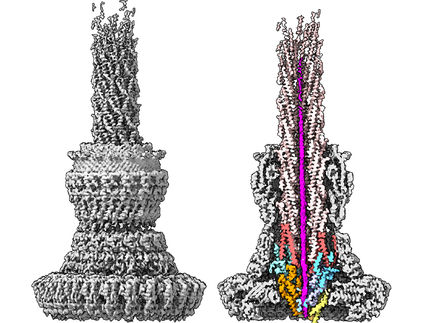Fighting the gram-negatives
Natural products inspire the design of molecular agents against drug-resistant bacterial strains
Many microorganisms produce secondary natural products, the potential antibiotic effects of which are extensively investigated. German scientists have now examined a class of quinone-like substances containing an additional epoxide functional group for their antibiotic activities. As they report, the compounds can kill problematic Salmonella pathogens, probably by interfering with their bacterial stress response system.

© Wiley-VCH
Multidrug resistance is one of the most urgent problems in clinical research. It particularly concerns the gram-negative bacteria strains, which possess an outer membrane largely impermeable for small molecules. Scientists are continually screening natural secondary products of various structural motifs to investigate their effects as possible antibiotics, which could enter in the microorganism and possibly inhibit essential enzymes. Stephan Sieber, Iris Antes and their colleagues at Technical University of Munich were particularly interested in a class of molecules with a structural scaffold present in various natural products. Its quinone-epoxide motif could be crucial for antibacterial bioactivity, they assumed.
The scientists used click chemistry to label the molecular candidates with fluorescent dyes. Thus, in a proteomic approach, their--at this point unknown--protein targets within the microorganisms could be identified, once they interacted with the candidates. One of the candidates called FM233 was not only found to kill Salmonella, which is one of the most problematic pathogens, but its target proteins were identified as well. The scientists reported that two of the three proteins belonged to the cellular stress response machinery. "FM233 antibiotic activity stemmed to a large extend from downregulation of enzymatic stress response, and corresponding sensitization of cells to stress," they wrote. The function of the third of the three targeted proteins had been unknown before. However, after employing test systems on various possible activities, the scientists concluded "that this protein is not involved in the antibacterial mechanism of action."
The notion that FM233 can intervene in the bacterial stress response system could be a good starting point for further research on the antibacterial activities of that particular molecular scaffold. As only small chemical changes can cause strong responses, the battle against resistance is ongoing.
Original publication
Most read news
Original publication
Franziska A. Mandl et al.; "Naturstoffbasierte Aminoepoxybenzochinone inhibieren das Wachstum verschiedener Serovare des Gram-negativen Krankheitserregers Salmonella durch Abschwächen der bakteriellen Stressabwehr"; Angewandte Chemie; 26 October 2016
Topics
Organizations
Other news from the department science

Get the life science industry in your inbox
By submitting this form you agree that LUMITOS AG will send you the newsletter(s) selected above by email. Your data will not be passed on to third parties. Your data will be stored and processed in accordance with our data protection regulations. LUMITOS may contact you by email for the purpose of advertising or market and opinion surveys. You can revoke your consent at any time without giving reasons to LUMITOS AG, Ernst-Augustin-Str. 2, 12489 Berlin, Germany or by e-mail at revoke@lumitos.com with effect for the future. In addition, each email contains a link to unsubscribe from the corresponding newsletter.


















































